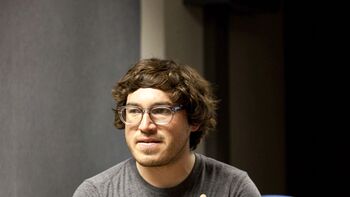Difference between revisions of "Mario de Vega"
m (Text replacement - "258px" to "350px") |
|||
| (6 intermediate revisions by the same user not shown) | |||
| Line 1: | Line 1: | ||
| − | + | [[Image:Mario de Vega.jpg|thumb|350px|Mario de Vega. [http://noiselab.com/blog/arte-blog/mario-vega-arte-sonoro-geometria-variable/] ]] | |
| + | '''Mario de Vega''' (1979, Mexico City) is an experimental sound artist. His works include site-specific interventions and experiments in psychoacoustics that frequently push the limits of audio perception. He uses challenging frequencies said to induce visceral reactions in the audience, and sound as a tool to confront contemporary issues around and personal experiences of vulnerability. | ||
| + | Working in the fields of sound and conceptual visual arts since 1999, and [[Berlin]]-based since 2008, de Vega uses the exhibition space as a springboard to reflect on the realities outside of the architectural environment. Using large-scale pyrotechnics and aggressive high/low frequencies, his aims at agitation are an intrinsic part of the performative experience. A frequent focus on the corruption and violence in Mexico, de Vega also esteems the process, including negotiations leading to the performance, as an important part of his own research. | ||
| − | + | Installation locations have included significant Baroque churches, museum courtyards, and functioning sewage systems, while gunpowder continues to be a frequent ally. | |
| + | De Vega’s studies in Mexico City included linguistics, Stage Design, and Sound for Theater, as well as the Sound Studies Masters Program at Berlin’s UDK. The artist continues to exhibit and perform across Europe, Mexico, North America, South Africa, India, Russia, and Japan. [https://www.ctm-festival.de/archive/all-artists/k-o/mario-de-vega/ (2017)] | ||
| − | [[Category:Circuit bending| | + | ; Links |
| + | * http://mariodevega.info | ||
| + | * http://www.mariodevega.info/folio/ | ||
| + | * http://vimeo.com/36498190 | ||
| + | * http://soundcloud.com/sottovocefestival/mario-de-vega-f13 | ||
| + | * http://r-aw.cc | ||
| + | * http://enhe.info | ||
| + | * http://f4rm.org | ||
| + | |||
| + | [[Category:Sound art|Vega, Mario de]] | ||
| + | [[Category:Circuit bending|Vega, Mario de]] | ||
Latest revision as of 23:55, 25 May 2022

Mario de Vega (1979, Mexico City) is an experimental sound artist. His works include site-specific interventions and experiments in psychoacoustics that frequently push the limits of audio perception. He uses challenging frequencies said to induce visceral reactions in the audience, and sound as a tool to confront contemporary issues around and personal experiences of vulnerability.
Working in the fields of sound and conceptual visual arts since 1999, and Berlin-based since 2008, de Vega uses the exhibition space as a springboard to reflect on the realities outside of the architectural environment. Using large-scale pyrotechnics and aggressive high/low frequencies, his aims at agitation are an intrinsic part of the performative experience. A frequent focus on the corruption and violence in Mexico, de Vega also esteems the process, including negotiations leading to the performance, as an important part of his own research.
Installation locations have included significant Baroque churches, museum courtyards, and functioning sewage systems, while gunpowder continues to be a frequent ally.
De Vega’s studies in Mexico City included linguistics, Stage Design, and Sound for Theater, as well as the Sound Studies Masters Program at Berlin’s UDK. The artist continues to exhibit and perform across Europe, Mexico, North America, South Africa, India, Russia, and Japan. (2017)
- Links